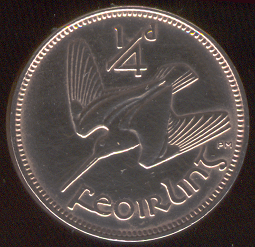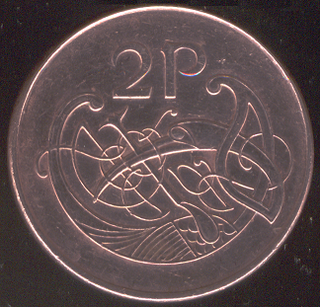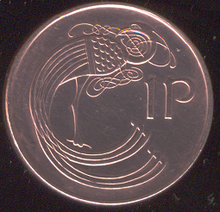
The standard circulating coinage of the United Kingdom, British Crown Dependencies and British Overseas Territories is denominated in pennies and pounds sterling, and ranges in value from one penny sterling to two pounds. Since decimalisation, on 15 February 1971, the pound has been divided into 100 pence. Before decimalisation, twelve pence made a shilling, and twenty shillings made a pound.

The British decimal one penny (1p) coin is a unit of currency and denomination of sterling coinage worth 1⁄100 of one pound. Its obverse featured the profile of Queen Elizabeth II since the coin's introduction on 15 February 1971, the day British currency was decimalised, until her death on 8 September 2022. A new portrait featuring King Charles III was introduced on 30 September 2022, designed by Martin Jennings. Four different portraits of the Queen were used on the obverse; the last design by Jody Clark was introduced in 2015. The second and current reverse, designed by Matthew Dent, features a segment of the Royal Shield and was introduced in 2008. The penny is the lowest value coin ever to circulate in the United Kingdom.

The British decimal two pence coin is a denomination of sterling coinage equalling 2⁄100 of a pound. Since the coin's introduction on 15 February 1971, the year British currency was decimalised, its obverse has featured four profiles of Queen Elizabeth II. In 2008 the design on its reverse changed from the original depiction of a plume of ostrich feathers with a coronet to a segment of the Royal Shield.

The pound was the currency of Ireland until 2002. Its ISO 4217 code was IEP, and the symbol was £ The Irish pound was replaced by the euro on 1 January 1999. Euro currency did not begin circulation until the beginning of 2002.

Decimal Day in the United Kingdom and in Ireland was Monday 15 February 1971, the day on which each country decimalised its respective £sd currency of pounds, shillings, and pence.

The pound is the currency of Jersey. Jersey is in currency union with the United Kingdom, and the Jersey pound is not a separate currency but is an issue of banknotes and coins by the States of Jersey denominated in sterling, in a similar way to the banknotes issued in Scotland and Northern Ireland. It can be exchanged at par with other sterling coinage and notes.

The farthing was the lowest value coin of the pre-decimal Irish pound, worth a quarter of a penny, 1⁄48 of a shilling or 1⁄960 of a pound. The coin had lost much of its value through inflation long before decimalisation in 1971, and during the 1960s no farthings were produced for general circulation; those minted in 1966 were produced for collectors' sets.

The halfpenny coin was the second smallest denomination of the pre-decimal Irish pound, worth 1⁄480 of a pound or 1⁄24 of a shilling. First issued in 1928 it ceased to be legal tender on 1 August 1969.

The penny (1d) coin was the third-smallest denomination of the pre-decimal Irish pound, worth 1⁄240 of a pound or 1⁄12 of a shilling. To express an amount, penny was abbreviated to "d", e.g. 1d, from the Roman denarius. It was introduced in 1928 to replace its British counterpart, used when all of Ireland was a constituent country of the United Kingdom. The last year of minting was 1968 and it ceased to be legal tender on 31 December 1971.

The threepence or 3d coin was a subdivision of the pre-decimal Irish pound, worth 1⁄80 of a pound or 1⁄4 of a shilling. Leath reul literally means "half reul", the reul being a sixpence coin worth about the same as the Spanish real. As with all other Irish coins, it resembled its British counterpart, as the Irish pound was pegged to the British pound until 1979.

The sixpence coin was a subdivision of the pre-decimal Irish pound, worth 1⁄40 of a pound or 1⁄2 of a shilling. The Irish name réal is derived from the Spanish real; for most of the 19th century, a pound sterling was equal to five U.S. dollars, and a dollar was equal to eight reales, so that a real was equal to 1⁄40 of a pound. The variant spelling reul was used in the Coinage Act 1926, and appeared on the coins themselves even after a 1947 spelling reform established réal as the standard.

The ten shilling (10s) coin was a one-off commemorative coin issued in Ireland in 1966 to mark the 50th anniversary of the Easter Rising. Ten shillings was a subdivision of the pre-decimal Irish pound, worth 1⁄2 of an Irish pound, making this the highest-value coin in the pre-decimal system.

The decimal halfpenny coin was the smallest denomination of the Irish pound. It was first issued when the Irish currency was decimalised on Decimal Day, 15 February 1971. It was one of three new designs introduced all in bronze and featuring ornamental birds on the reverse. The coin value was weakened by inflation and very few were produced beyond the initial run for 1971. It was removed from circulation and demonetised on 1 January 1987.

The two pence (2p) coin was the third smallest denomination of the Irish pound, being worth 1⁄50 of a pound. It was first issued on Decimal Day, 15 February 1971. The coin was minted until 2000. It was the third of three new designs introduced all in bronze, the others being the halfpenny and penny. All featured ornamental birds on the reverse.

The five pence (5p) coin was a subdivision of the Irish pound. It was introduced in Ireland on Decimal Day, 15 February 1971 and reused the design on the shilling coin produced for the Irish Free State in 1928. Some shilling coins remained in circulation until the early 1990s, with the same nominal value as the five pence coin.

The ten pence (10p) coin was a subdivision of the Irish pound. It was used in the Republic of Ireland from 1969 to 2002, with its last minting issue in 2000. It replaced the florin coin, of which it shared its design. Two different designs of the coin exist, both featuring a salmon on the reverse. The second was introduced in 1993 and is smaller, due to the reduction of the coin's value by inflation.

The twenty pence (20p) coin was a subdivision of the Irish pound. It was introduced on 30 October 1986. It was the first Irish decimal coin of a different size to the corresponding British coin, as the Irish pound had not been pegged to sterling since 1979. Its last issue was in 2000, two years before Ireland withdrew its pound for the euro.

The fifty pence (50p) coin was a subdivision of the Irish pound. It was introduced in Ireland on 17 February 1970. It replaced the ten-shilling coin and ten-shilling note when decimalised, and due to this conversion was introduced a year before Decimal Day in 1971.
There have been three sets of coins in Ireland since independence. In all three, the coin showed a Celtic harp on the obverse. The pre-decimal coins of the Irish punt had realistic animals on the reverse; the decimal coins retained some of these but featured ornamental birds on the lower denominations; and the euro coins used the common design of the euro currencies. The pre-decimal and original decimal coins were of the same dimensions as the same denomination British coins, as the Irish punt was in currency union with the British pound sterling. British coins were widely accepted in Ireland, and conversely to a lesser extent. In 1979 Ireland joined the Exchange Rate Mechanism and the Irish punt left parity with sterling; coin designs introduced after this differed between the two countries.

The British pre-decimal penny was a denomination of sterling coinage worth 1⁄240 of one pound or 1⁄12 of one shilling. Its symbol was d, from the Roman denarius. It was a continuation of the earlier English penny, and in Scotland it had the same monetary value as one pre-1707 Scottish shilling. The penny was originally minted in silver, but from the late 18th century it was minted in copper, and then after 1860 in bronze.



















